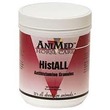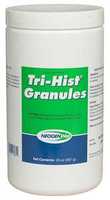Pronunciation
an-teye-HIS-ta-meens - Pronunciation guide
Brand Names
- AniHist
- Hist-EQ Powder
- HistaGranules
- HistALL
- Tri-Hist® Granules
Description
 Antihistamines are used to counteract histamines that lower blood pressure and cause the inflammation and itching of allergic reactions. Although antihistamines do not block the release of histamine, they compete with histamine for uptake at the histamine receptors on sensitive cells in the respiratory tract, intestines, blood vessels, and skin.
Antihistamines are used to counteract histamines that lower blood pressure and cause the inflammation and itching of allergic reactions. Although antihistamines do not block the release of histamine, they compete with histamine for uptake at the histamine receptors on sensitive cells in the respiratory tract, intestines, blood vessels, and skin.
Usage
Pyrilamine maleate and tripelennamine are used to treat allergic reactions in horses. Injectable antihistamines, such as pyrilamine maleate and tripelennamine, act rapidly and are often used for allergic reactions such as tongue or facial swelling due to bee sting, insect bite, or contact with an irritating plant. Oral antihistamines take longer to act and are often used in cases of itching and swelling due to allergic skin problems.
In cases when antihistamines alone are unable to control all allergic signs, they may be used with corticosteroids, thereby allowing use of a lower dose of corticosteroids.
Dosage and Administration
 Antihistamines Antihistamines |
||||
|---|---|---|---|---|
| Method | Dosage (click row for calculator) |
Concentration | Period | Duration |
| Oral | 30 mg/100lb Tri-hist granules | 600 mg/oz | Every 12 hours | NA |
| Intravenous, Intramuscular or Subcutaneous injection | 0.9-1.3 mg/kg Pyrilamine maleate | 50 mg/ml | 2 to 4 times daily | NA |
| Intramuscular injection1 | 0.5 mg/lb Tripelennamine hydrochloride | 20 mg/ml | 2 to 4 times daily | NA |
Notes:
|
||||
Side Effects
The most common side effect of antihistamines is sedation. Other side effects include excitement, tremors and seizures, colic, and loss of appetite.
Precautions
Individual horses may react differently to antihistamines and dosage should be based on the horse's age and condition. Antihistamines may thicken mucus in the respiratory tract, so extra precautions should be taken when used to treat horses with respiratory problems. Directions for administration should be followed with injections of pyrilamine given slowly since rapid administration increases the possibility of side effects. Tripelennamine should be administered intramuscularly.
Pyrilamine and tripelennamine are FDA approved for use in horses. U.S. federal law restricts this drug to use by or on the lawful written or oral order of a licensed veterinarian.
Pyrilamine maleate and tripelennamine are prohibited or regulated in most sanctioned competitions. Consulting the individual regulatory group is essential for determining provisions in rules for the therapeutic use of these substances.
Interactions
Antihistamines may affect the activity of anticoagulant drugs such as warfarin. When combined with other central nervous system depressant drugs, such as tranquilizers, antihistamines have an additive effect.
Overdose
Overdoses may cause increased sedation and severity of other side effects.
Images
 HistAll
HistAll
 Tri-Hist
Tri-Hist
Product labels
The drug labels on this website represent drug information listings as submitted to the FDA.The drug labels on this website have not been altered or modified by EquiMed. The drug labels on this website may not be the most current or identical to the current labels shipped with the product. Contact your veterinarian or the manufacturer for the latest information on this drug or medication prior to use.
